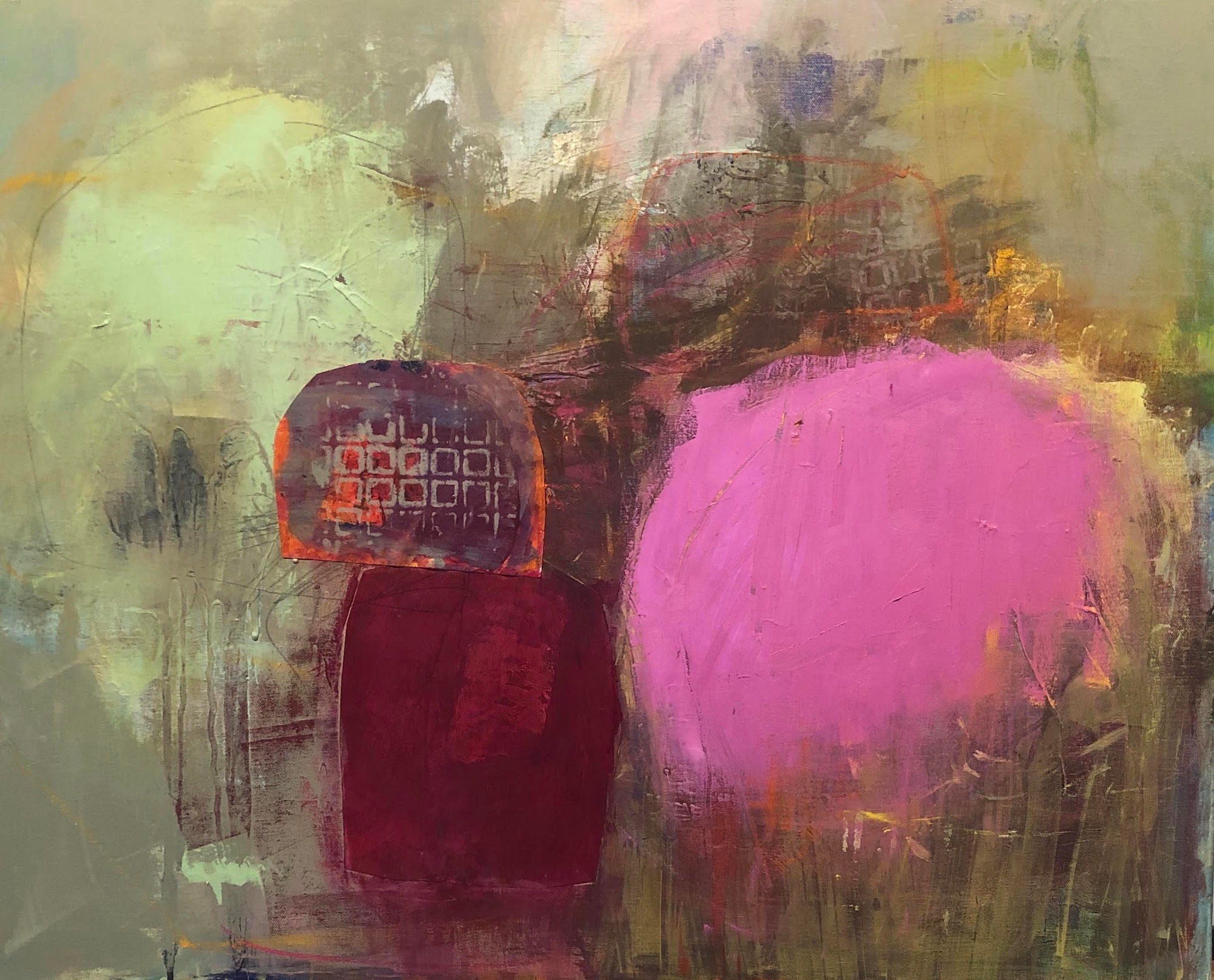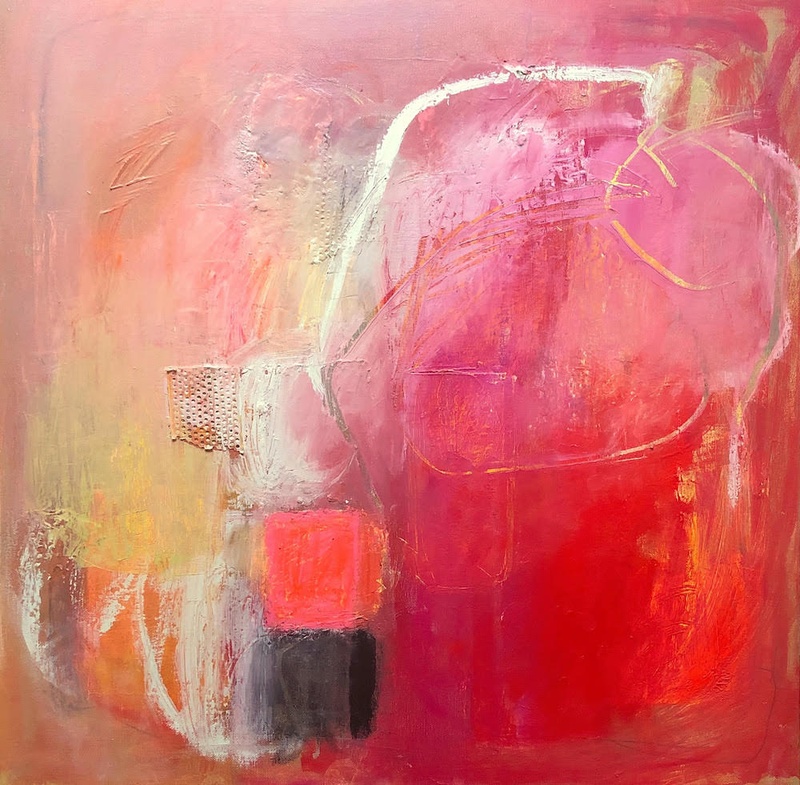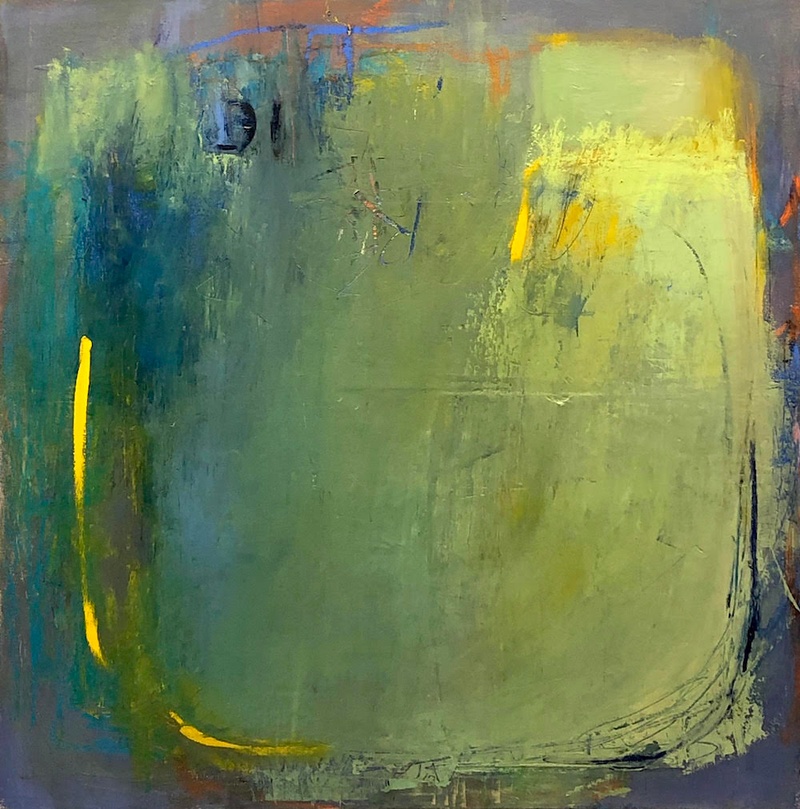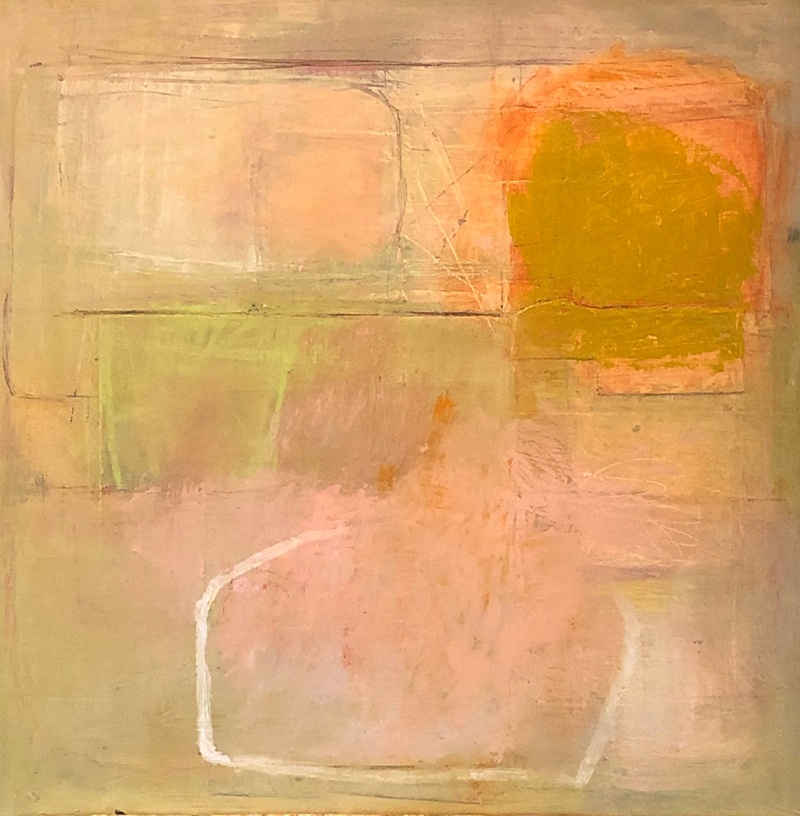What first?
When I look at a painting or read a poem or experience any kind of art, I am very aware of the physical sensations that let me know how I feel about it. If I feel that thud in my solar plexus, or that vibration in my chest or that that tingling in my head, I am drawn to the work, my own or someone else’s. It is just like falling in love with a person, you know the signs.
What are the signs?
I use that wonderful quote by Maya Angelou as a touchstone. “People will forget what you said, people will forget what you did, but people will never forget how you made them feel.” I want to feel something when I’m making paintings, and I want others to feel something as well, when they look at my paintings. What they feel is completely up to them.
So then you know when you are doing your own best work when you feel something from it? My friend who writes music complains his work is no good so I said, ‘Why don’t you just write your favorite song?’
That’s exactly right! I’ll often look at some of my favorite paintings before I paint, just to get revved up. I go into the studio thinking that I want to make painting just like that, while knowing that my painting will never end up looking like that. But I am using the feeling I’m getting from someone else’s painting…Buddhists call it sympathetic joy.
Being happy for someone else’s happiness, yes. Is there ever someone’s painting that you have returned to more than once to paint the feeling of?
I love a lot of different painters in many different genres. These days the Minimalists are exciting me, people like Ellsworth Kelly, Agnes Martin, and Color field artists like Barnett Newman. Often I’ll go to Instagram and scroll through #minimalism, there are so many people doing amazing work, and they are often fairly unknown.
I like what the Buddhists say about impermanence. That life is always changing and cannot be controlled so don’t try and control it. Maybe getting to the easel or the desk to work on our art for just ten minutes a day is the best we can do to control our lives. And that too is futile isn’t it?
Control is such a loaded word these days. I just looked up the derivation of it, which is something I love to do when I am trying to understand a word. It comes from latin contra, against, and rotulus, wheel. Isn’t that perfect! Against the wheel. Stopping the flow. If we are in the flow we don’t need control, I guess is my take away. Makes sense to me.
Dreaming in Red.
That’s what I love about art. We cannot master it, ever. Or others say we have, but we know we haven’t gotten close to what is possible from ourselves. Over the decades how have you seen your own work grow? Has anything gotten easier?
I want to tell you that what you just said is so true, that I feel I haven’t gotten close to what is possible. I always start with that exciting feeling of limitless vision. But I am never satisfied, truly, and I have learned that it is okay to feel that way. Which makes things easier.
Do you have a set of rules you apply to your own work?
I once had a teacher in a painting workshop ask me if I went to art school. When I said, no, she said, that’s good! That was surprising coming from someone who had her master’s degree in painting. But she was trying to teach us to break the rules, and maybe it was easier for me because I had not been hammered with rules in school. But I feel that there are rules that I follow, and they are mostly about contrast. There has to be enough contrast to keep someone looking at the painting. In one painting I was doing I was trying to get the clouds to be light enough. I kept adding more white I’m until it dawned on me, make the sky darker! The way I work with the darks and lights is key. Even a little bit of contrast works wonders to get the feeling across.
I teach that to students in writing workshops, or tell that to people when I edit their books. The beauty/ugliness, pain/joy, it is like two creatures on a seesaw and I want the seesaw balanced. More depth that way.
Creating dynamism. Yes, I am very much into balance. In painting it keeps the viewers attention moving around the canvas.
In a story I guess that dynamism moves the reader through their life.How do you choose a subject?
This spring during lockdown I went into my studio every day and painted flowers that I took from my neighbor’s garden. I would first take a walk, trying to get rid of the stress I was feeling. I would see the daffodils shining buttery yellow and would get that feeling of falling in love. They chose me. I had to paint them. We live in a fantastically beautiful area, with Seneca lake across the road and gorges and gullies criss-crossing all of the properties. I usually take a walk down to the lake before I head for the studio. The air is so clarifying! The neighbor is an old friend, he makes beautiful instruments. We keep an eye on the property when he is away. For months he’s been stranded in Spain.
I can understand being drawn to a figurative subject, like a flower, but how do you chose an abstract subject?
When I am painting an abstract subject I start by putting color down until I get that same feeling, like I have to follow this path and see what happens. Sometimes I reach a dead end. But sometimes I discover treasure.
When you get dead ended, what then? Paint over it? Or let the work sit and then speak to you from a dusty corner later?
Both of those things. Have you ever been driving or been in a train and as you sped by the landscape you got a glimpse of something that was so beautiful? That has happened to me when I’m driving, and sometimes I’ll stop the car and go back to take a photo of what I thought I saw. But the straight-on look at it is never as beautiful as that passing view. I never understood why until I realized that my imagination is activated by that quick glance. I use that idea to help me sometimes. I’ll have a painting that I am stuck on, sitting against the wall, yes in a corner, and I ignore it until I happen to see it out of the corner of my eye. Often then I will see what it needs.
That’s amazing.
I used to be so disappointed when I’d turn the car around and go back to take a photo to find nothing that exciting! I think a lot of painters use this concept. I have a painter friend in Cleveland who recently did a series she called drive-bys, landscapes based on memories of driving through the landscape. Stuart Shils, a well known contemporary painter takes photos from moving vehicles, not to make them into paintings, but as a creative outlet, I think. Is there a corollary with writing?
Just fantasy, blurring what happened with what we wish would happen or with what we always dreaded would happen. The Devil broke the door down and carried us away in our Sunday best and we liked it.
Yes! That resonates!
Vessel Series #1.
Writers can just lie and distort. The lid to the cake is lifted and instead of a cake there is a million dollars. Paintings I enjoy most, like yours, find a fuzzy grace the everyday. I’m not drawn much to photorealistic paintings. I mean, we’ve got cameras.
Whether I like a genre of art or not, I look for reasons to appreciate it so I don’t let the negative judgment block me from creating something. I don’t always succeed in my appreciation, but I am aware that judgements that I have can cripple me. It’s not that I I have to love everything, but I try to be aware of my biases.
When did you begin painting?
About 20 years ago. It was not something that I ever dreamed about doing, it happened suddenly. My husband Michael and I were in Bavaria and walking in the countryside early in the morning. The fields were so overwhelmingly gorgeous that I couldn’t believe it. Then I heard this voice in my head saying, “You can paint this.” I told Michael, who is a painter and ceramic artist himself, I think I can paint. He didn’t flinch. He bought me tubes of oil paint and canvases and I soon realized that, “No, I can’t paint.” But by then I really, really wanted to, so I took every book I could find out of the library and started studying. It became such an obsession. I created a studio out of a bedroom and set up apples on a table and painted them. I used to hesitate telling this story because I thought it all sounded wow-woo.
Oh, like when somebody dies and the bluebird comes and we’re like—look there’s grandpa.
Over the years I’ve learned that many people have had experiences like that, a voice in one’s head urging, “You can paint this.” It’s about trusting ourselves and actually listening to that inner voice.
But what were you doing in those Bavarian fields?
We were visiting a family from Germany who had a cottage in Bavaria. The sweet story is that when Michael was a teenager his family had a foreign exchange student from Germany named Rudolph. Michael and Rudolph became lifelong friends, and when his son, Sebastian, was 17 he came to us for his senior year of high school. Rudolph’s family invited us to Germany for a visit after that.
All our work is in conversation with all the people we’ve met, even by chance, all the places we’ve gone, even by chance. Our influences come from everywhere and from everything. Don’t they?
I see the world in terms of color, value and shapes, and my epiphany in Bavaria, I now realize, came because I was seeing the landscape not as what I’d always thought is was, grass, hills, trees, but rather as a gorgeous interlocking of colors, values and shapes. The world never looked the same to me after that. All of my paintings reflect that understanding
How has your paining changed over the years?
I feel that I am freer to make bad paintings now than I used to be.
You don’t strive to paint a masterpiece each time?
Of course I do!
I don’t sit down and try to write the best thing I’ve ever written, or maybe I fool myself for a while and clown around, but you come to the work with your game face on?
I usually have this excited feeling of the limitlessness of what I can do, and it spurs me on, but I become aware as I proceed, as I wrestle with color, brushstrokes, slap paint down, scrape it off, get my hands dirty, and I make peace that I am not going create that masterpiece that was in my bones. Oh, well.
You’re right to use the word “freer” because a lot of artists are paralyzed at making “bad art.” What happens to one of your “bad” paintings?
Often I paint over them. The ghost images that show up from what is under the new painting are always a surprise and add to the depth and excitement of the painting.
How has the pandemic changed your approach to your art?
The obvious answer is that now I have more time to paint. But more than that, the pandemic has made me realize that connection is of utmost importance, and that one important way that I connect is by sharing my art. I am less self conscious about doing that now.
You began posting photos of your painting on instagram and selling them almost immediately as they went up. Did that surprise you? I have found that art has gained a lot more importance in people’s lives now that they are stuck in their homes. They are staring at a blank wall and want it to be beautiful…
I think that art has been a lifesaver for people during this time, both the appreciating of it and the creating of it.
If someone wanted to begin paining today just as you did with the apples on the table, how would you recommend they go about doing that?
I once told a friend who wanted me to teach her how to paint that what I would want do with her was take some eggshells, place them haphazardly on a table, light them from the side, and just admire how absolutely beautiful they were. Seeing comes first, then technique. I don’t think it’s about permission to paint as much as permission to see. There is a beautiful quote by French poet Paul Valery, “To see is to forget the name of the thing one sees.” Or, Picasso puts it more bluntly:” If only we could pull out our brain and use only our eyes.”
Vessel Series #2.
Is it important to understand figurative painting in order to paint abstract?
This is almost like a trick question because it is based on a concept that doesn’t necessarily make sense to me. I took many art history classes in college and we dissected paintings in regards to composition, value, historical allusion etc. But ultimately when I started painting it was not because I finally understood anything. When I went from figurative painting to abstract painting it was not that I said, Now I can paint abstractly because I understand figurative painting. It is all the same, really. Color, value, and shape.
Maybe it is a trick question, you once told me that after learning how you liked to compose your figurative painting, it helped you compose and block an abstract painting….Not to say you had mastered figurative, but that the skills of that did transfer over
That’s true, I did say that, and I meant it at the time. My ideas and understanding have evolved a lot in the last few years. I really see more and more that whether painting figuratively or abstractly, it’s all the same thing. Shape, color value. And feeling, first and foremost.
It’s the same way with me, I’ll think I know how to write a short story, or a novel, but when it’s time to sit down and write the next one, nothing I thought I understood will help.
Tell me about piano tuning.
I have been tuning and repairing pianos for over thirty years When I take a piano apart and sit down to tune it, it is like coming home. It is one long meditation, and like meditation, sometimes it feels tedious and horrible, and sometimes it feels transcendent. I feel like I am sculpting sound. Sometimes it is fighting a battle, and sometimes it is feeling that silky marble turn into a statue of David.
Painting is meditation, too?
If meditation is about being aware of the spaciousness that surrounds the mind and is not the mind, then yes, painting can be meditation. In the best of times, for sure.
You are a musician as well?
I think I approach music the same way that I approach painting, by letting the energy flow through me. In the best of times, that happens. In my music I have not taken things as far as I have with my painting, so I often don’t push on after that initial honeymoon period is over. With painting I have explored things much more deeply, experienced many more ups and downs, and have come to many more realizations than I have with my music.
But you push on with your painting. Always. What keeps you going back to your studio and painting?
In the most basic way, art in all forms has made life bearable. Art and love. Without my art, personally, I think I’d be really bored. I work in a converted garage that Michael re-did for me. Together we created a space that is light and inviting and I just love to be in there. It is mine and mine alone and in it I can do whatever I want. Sometimes I just go there and listen to music. I have all of my toys … paints, pastels, brushes, gouging tools, sandpaper, crayons, etc. Like a big kindergarten room. Who wouldn’t want to go out there there and play? But just as in any kindergarten, it’s not always nonstop happiness. Fights break out (between me and the work), hurt feelings arise, bad moods come up, and I find myself at odds with myself and my materials. I have learned to better tolerate these feelings by knowing that they will pass. Or by eating a grilled cheese sandwich.
Ileen Kaplan Recommends:
Dick Taylor Craft Chocolate, Dark, Brown Butter, Nibs, and Sea Salt. Made in Eureka California. I just get some for Christmas. So rich, and the bits of sea salt really zing!
Ian Stone’s Simpawtico puppy training videos.You can find lots of them on youtube or on his website. We just got a puppy, and his techniques work. All about love.
R and F oil paint sticks. Luscious! And the colors!
Brian Rutenberg Studio Visits, videos on youtube. Whether you like his paintings or not (I do), his takes on painting, color, and life are fascinating, and having been a full-time painter for many years, he has some great advice.
Haruki Murakami’s books, almost any of them. His prose is like a crystal clear stream, but his plots are convoluted, surreal, and almost science fiction-y. Start with the short novel Kafka on the Shore, or jump into his latest long one, Killing the Commendatore.
 Big.Pink.Bang.
Big.Pink.Bang.
This post was originally published on The Creative Independent.


